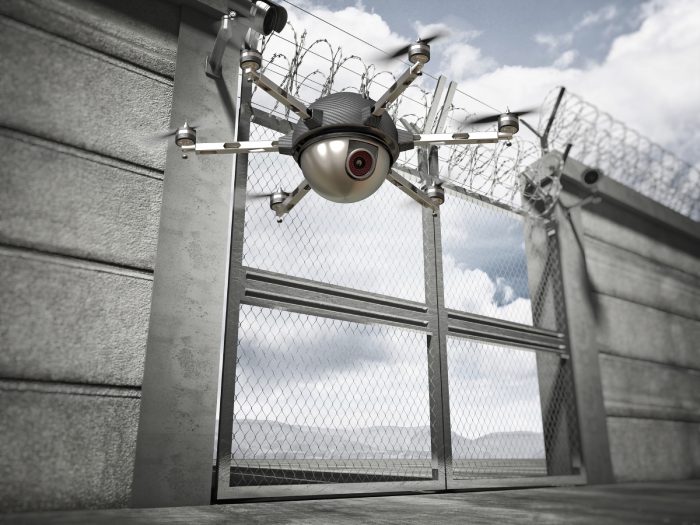By Anthony Galante, Faculty Member, Criminal Justice, American Military University and Jeremy Nikolow, alumnus, Criminal Justice, American Military University
Creating change in the criminal justice field does not often go over well. But, like life, change in law enforcement is inevitable. Both crime and crime-prevention strategies are always evolving in response to technological advances. One of the more recent and highly prolific technological developments involves unmanned aircraft systems (UAS), more commonly known as drones. These airborne devices have quickly become an effective tool for criminal activity. Drones are currently being exploited to commit criminal acts and law enforcement agencies must acquire countermeasures to minimize how drones are being used to facilitate illegal activities.
How Drones are Being Used and Abused
Drones are unmanned flying aircraft that can be controlled by an operator or autonomously programmed using computer software to be flown according to GPS coordinates. Drones come in various shapes and sizes and can be customized to carry out specific functions. Recent technological advancements and strong commercialization has made drones much more affordable to the public and there has been a rapid influx of devices into the market.
[Related Article: FAA Addresses Threats of Drones to the Nation’s Airspace]
These devices have become so popular that the Federal Aviation Administration (FAA) recently released a statement that there were more registered drone operators in the U.S. than licensed pilots. According to the Consumer Electronics Association (CEA), drone sales in 2015 were projected to reach 400,000 units. The CEA also reported that the number of drone flights per day could reach 1 million by the year 2035.
While the majority of drone operators use this technology for legitimate activities (e.g. government, business, recreation, etc.), criminals are also using them in the commission of criminal acts, notably in the smuggling of weapons, tools, cellphones, and other illegal contraband into correctional facilities.
Drone Intrusions on Correctional Facilities
In August 2015, Thaddeus Shortz was arrested for attempting to use a drone to smuggle narcotics, pornography, and a cellphone into Maryland’s Western Correctional Institution. Just two months later, a drone carrying hacksaws, illegal narcotics, and a cellphone was intercepted as it attempted to breach the Oklahoma State Penitentiary. Such instances have become an international complication as well, as there were nine drone-using attempts to smuggle items into prisons throughout England and Wales during the first few months of 2015.

These characteristics have caused drones to become a substantial threat to prison security. Drone intrusions could deliver inmates everything from tools for escape to weapons. Although private drones do not currently have the capability to carry the weight of a human, it is only a matter of time before such advances are made and the threat of inmates being flown out of prison becomes real.
How Agencies Can Address Drones
Unfortunately, there is no simple solution to the problem of drone intrusions within correctional facilities.
Shooting Down UAS?
The FAA considers all UAS weighing over 0.55 pounds to be an aircraft, according to the following definitions:
- The term “unmanned aircraft” means an aircraft that is operated without the possibility of direct human intervention from within or on the aircraft; Pub. L. 112-95 SEC 331.
- An aircraft means any contrivance invented, used, or designed to navigate or fly in the air; 49 USC § 40102.
- Aircraft means a powered or unpowered machine or device capable of atmospheric flight […]; FSS 330.27.
Since UAS are considered aircraft, it is illegal to shoot them down. Most people believe UAS are toys, but the government makes it clear that drones are aircraft and cannot be shot down. Drones need to be registered and currently a pilot’s license is needed to fly them commercially. According to U.S. Code 18 USC § 32 (a), Destruction of Aircraft or Aircraft Facilities, whoever willfully does the following will be fined and/or imprisoned not more than 20 years:
- Sets fire to, damages, destroys, disables, or wrecks any aircraft in the special aircraft jurisdiction of the United States or any civil aircraft used, operated, or employed in interstate, overseas, or foreign air commerce;
- Sets fire to, damages, destroys, or disables any air navigation facility, or interferes by force or violence with the operation of such facility, if such fire, damaging, destroying, disabling, or interfering is likely to endanger the safety of any such aircraft in flight;
- Interferes with or disables, with intent to endanger the safety of any person or with a reckless disregard for the safety of human life, anyone engaged in the authorized operation of such aircraft or any air navigation facility aiding in the navigation of any such aircraft;
In addition, officers that shot at a drone would be responsible and liable for any errant rounds that miss the UAS. An officer is responsible for every round fired from his or her weapon. If an officer misses the UAS and the bullet hits someone or causes damage, the officer and agency are responsible.
Jam Radio Frequencies
Another often-discussed solution is to jam the radio frequency that the UAS operates on. However, this too is currently illegal and there is no exception that allows law enforcement to break this federal law. So, for example, if an agency jams the signal of a UAS and it falls out of the sky and kills someone, the agency would be held responsible. The Communications Act of 1934 prohibits anyone from manufacturing, importing, marketing, selling or operating any jamming devices within the U.S. (47 U.S.C. § 302a(b).
Attack Drones (or Birds?)
Some departments would like to launch a drone to catch a drone. Based on experience, I know it is a very tedious process to obtain the proper paperwork from the FAA to integrate a UAS into an agency. I do not know of any correctional agencies that have done this because it is difficult, time-consuming, and likely not worth the hassle since the FAA is expected to release new rules this summer. In addition, using an attack drone to counter drone intrusions would also assume that agencies have the ability to detect a drone when it enters their airspace, which is another layer of technological sophistication that most agencies do not possess.
In a similar approach to attack drones, Dutch police are training birds to intercept and take down UAS. While this is an interesting and possible solution, it also requires a significant amount of training and resources often not available to correctional agencies. Airport operators are considering using birds for drone interception and will likely have the resources and capabilities to test the effectiveness of this method before correctional agencies.
How the Government is Addressing this Threat
The FAA is working with several companies to develop and test UAS detection equipment that would be able to locate UAS and operators around airports. This technology uses sensors at various locations around an airport to triangulate where signals are emanating from. Once the location of the UAS and operator are known, local law enforcement can take appropriate action. What is appropriate action?
- Confront the operator and educate him or her about the safe operation of UAS
- Notify other agencies like the FAA and the National Transportation Safety Board
- Arrest the operator, which is dependent on current legislation in the jurisdiction
Despite not having specific regulations from the government, correctional and law enforcement agencies should develop a standard operating procedure for drone intrusions. This plan should outline the immediate actions that need to take place and who needs to be notified in case of a critical incident involving a drone. Even if correctional agencies possess the technology to detect and deter drone intrusions, they are limited to what happens near their property and will need to partner with police to respond to drones that fly beyond facility walls. In the meantime, correctional facilities should train officers to stay vigilant for drones; watching the sky for drone intrusions must become a standard part of the yard scan for all correctional officers.
Has your agency experienced drone intrusions? Is it concerned about drones? Has it developed tools to address the threat of drones?



Comments are closed.